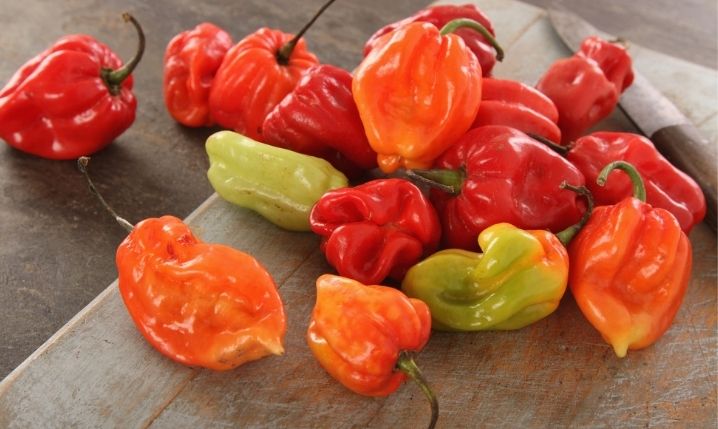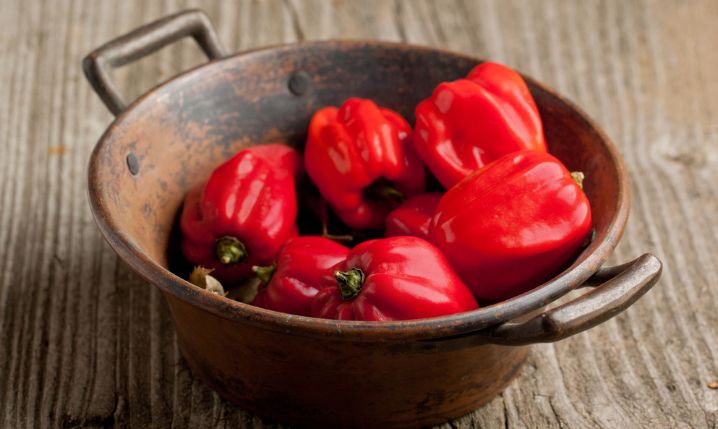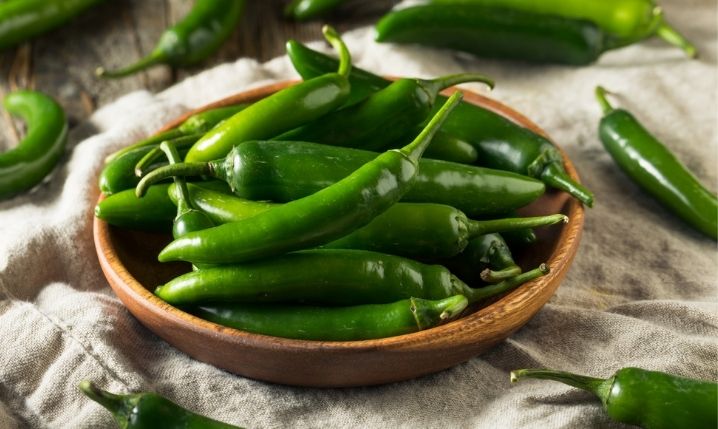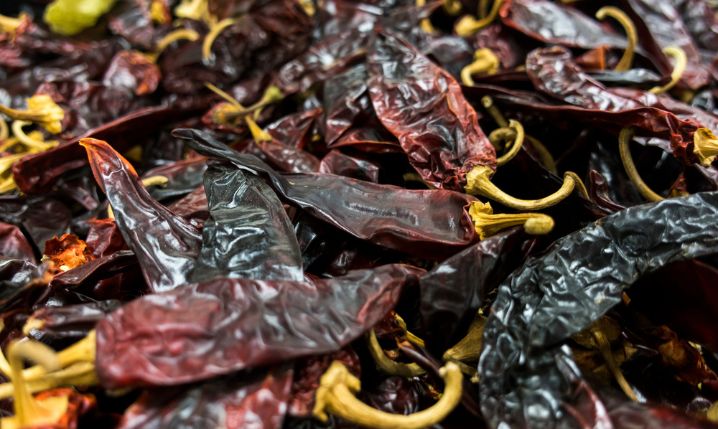A scotch bonnet is a type of chili pepper known for tasting both sweet and very hot. It’s a popular chili in Caribbean cuisine, with a Scoville heat unit rating of 100,000-350,000 SHU. It’s common for people to want or need a scotch bonnet pepper substitute, so read on to find out the best options.
Contents:
What Are Scotch Bonnet Peppers?

Scotch Bonnet chili peppers are famous chilies that are widely used in Caribbean cuisine for both the intense heat and sweet flavor they provide to dishes. They are sometimes known as Bonney peppers or Caribbean red peppers but are most known as scotch bonnets.
It is thought that these chilies originated in the rainforests of Brazil. However, they’re now widespread across the Caribbean region and Central America.
With a short, stout shape that often looks “squashed,” the scotch bonnet can vary in color from green to orange to red which is often a sign of how mature they are. The more mature the pepper, the deeper red the color. Sometimes they appear brown. Additionally, they become hotter as they mature.
The spice and slight sweetness are used to add a distinctive flavor to hot sauces, condiments, rondón, ceviche, jerk dishes, and more.
With a rating between 100,000-350,000 SHU, they are classified as ‘very hot’ chilies, which should be used with care during both preparation and how much you use in a recipe.
Substitutes For Scotch Bonnets
You can look at several suitable substitutions for the scotch bonnet pepper based on similar flavor, availability, and heat rating.
| Substitute | Taste | Scoville heat units (SHU) |
|---|---|---|
| Habanero Pepper | Sweet, Fruity, Smoky | 100,000 – 350,000 |
| Jalapeño Pepper | Bright, Grassy, Bitter | 2,500 – 8,000 |
| Serrano Pepper | Bright, Grassy | 10,000 – 23,000 |
| Guajillo Pepper | Tangy, Crisp, Smoky | 2,500 – 5,000 |
| Rocotillo Pepper | Sweet, Fruity | 1,500 – 2,500 |
1. Habanero Pepper

The habanero pepper is the best alternative to the scotch bonnet and is considered a spiritual brother by chili lovers worldwide.
One of the reasons it makes such an excellent substitute is that it has a similar sweetness to its overall taste while having the same SHU rating between 100,000 – 350,000 SHU. So these chilies are hot!
You can use the habanero pepper in the same recipes, including jerk chicken or pork, ceviche, and much more.
However, there are some minor differences between them, such as how the habanero isn’t quite as sweet as the scotch bonnet. That being said, the habanero is wildly popular, making it more widely available, especially in North America.
2. Jalapeño Pepper

Jalapeños make a surprising but excellent substitution for scotch bonnets. The most important thing to know about the differences between the two (other than the heat) is that the Jalapeño is often sold when it’s not mature.
Jalapeños get sweeter as they mature, so you would be best suited to waiting for them to mature or if you can find them purchasing mature jalapeños. The mature versions are red, not green.
You can use the green versions, but they don’t have close to the sweetness of a scotch bonnet.
If you want to turn up the heat, you can always use one teaspoon of cayenne pepper per 3 jalapeños.
3. Serrano Pepper

Serrano peppers are a good substitution when you don’t want something too mild or too hot. They have a bright grassy bite that works well with many dishes and foods like hot sauces, burgers, chili con carne, jerk chicken, and more.
One thing they do not add to the dish that you’ll get with other options on this list is the sweet flavor you expect and sometimes want from a scotch bonnet.
However, you can combine these medium-spice chili peppers with something milder on this list to add the desired sweetness while retaining the heat.
With a heat rating between 10,000 – 23,000 SHU, you will have to add something like cayenne pepper powder to increase the heat if you’re looking for something as hot as a scotch bonnet.
4. Guajillo Pepper

The Guajillo pepper is an excellent option for an interesting, distinctive sweet, smoky flavor that works well in sauces, salsas, jerk dishes, and jam when substituted for scotch bonnets.
One thing about these chilies is that they are harder to come across. They’re also relatively mild, so you do need to combine each pepper with ¼ teaspoon of red cayenne pepper to increase the heat. It’s because the Guajillo pepper has a SHU rating of only 2,500 – 5,000 that makes them too mild to make an exact replacement in most recipes.
Guajillo peppers have a thicker, waxier skin than scotch bonnets, which means you should only use them in dishes where the chewy bite isn’t going to ruin your meal.
5. Rocotillo Pepper

Finally, we have the rocotillo pepper, a lesser-known chili pepper that, like the scotch bonnet, is commonly used in Caribbean cuisine.
It is a mild chili with a 1,500 – 2,000 SHU rating that requires combining with other chilies like habaneros to give you both the heat and the sweetness of the rocotillo pepper to create an ideal alternative to a scotch bonnet.
The sweetness of the rocotillo makes them a good alternative, but you’ll need more than a couple of these to work with as they are small, squashed-looking chilies that require some careful knife skills to prepare well for many recipes.
With a sweet, fruity flavor, the rocotillo pepper does make a good substitute for almost any situation, with the caveat of being combined with something else to add the required heat.
Conclusion
No matter what reason you need a scotch bonnet substitute, whether it’s because of availability or because you want something without so much heat – there are a lot of good options that you can use as either direct substitutes or as good ones that become excellent with a few additions and tweaks.
More about Scotch Bonnet Peppers: